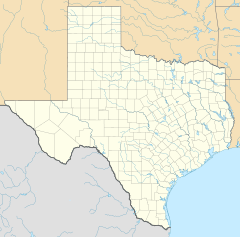Fort McKavett, Texas facts for kids
Quick facts for kids
Fort McKavett
|
|
|---|---|
| Country | United States |
| State | Texas |
| County | Menard |
| Elevation | 2,169 ft (661 m) |
| Time zone | UTC-6 (Central (CST)) |
| • Summer (DST) | UTC-5 (CDT) |
| ZIP codes |
76841
|
| GNIS feature ID | 1357592 |
Fort McKavett is a ghost town located in Menard County, Texas, in the United States. A ghost town is a place where most people have moved away, leaving behind empty buildings. It sits where two roads meet, about 20 miles southwest of Menard, which is the main town in the county. The area is about 2,169 feet (661 meters) above sea level. It even has its own post office!
Contents
History of Fort McKavett
Early Days as Scabtown
The story of Fort McKavett began in the 1850s. At that time, it was a small civilian settlement called Scabtown. It was located just north of a military camp named Camp San Saba. This was in Menard County, not the other Camp San Saba in McCulloch County.
Military Fort and Civilian Growth
In 1859, Camp San Saba closed. Many people living nearby moved to safer areas because of attacks from Native American tribes. But in 1869, the United States Army reopened the outpost. They named it Fort McKavett.
As more people moved to Scabtown, the community grew. It was then renamed after the fort, becoming Fort McKavett. The local economy started to do very well.
Life After the Fort Closed
The Army closed Fort McKavett for good in 1883. However, Native American tribes had been moved to other areas earlier. This made the civilians feel safe enough to stay in Fort McKavett.
The town continued to grow. Its economy supported two hotels, three churches, a newspaper, and even a mattress factory! At the start of the 1900s, the population reached its highest point with about 150 people. But in the second half of the century, the number of residents slowly went down.
A Writer's Visit
In 1933, a writer named Robert E. Howard visited Fort McKavett. He loved Texas history. He wrote that McKavett was "fascinating." He described it as a village of ruins and half-ruined buildings. People were living in the old barracks and officers' quarters that were still in good shape.
Climate in Fort McKavett
The weather in this area has hot, dry summers. The winters are usually mild to cool. According to a system called the Köppen climate classification, Fort McKavett has a mid-latitude arid desert climate. This means it's a dry place, similar to a desert, but not always extremely hot.



